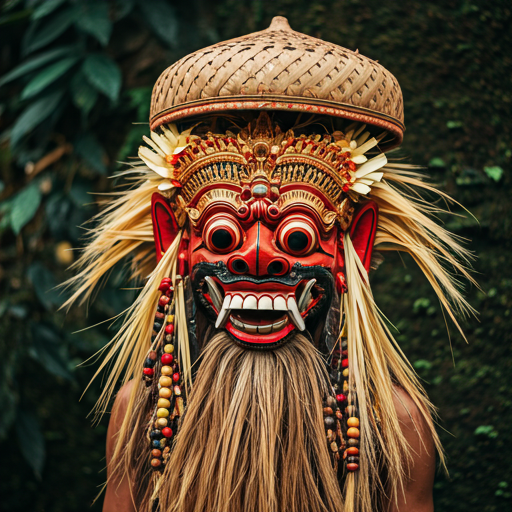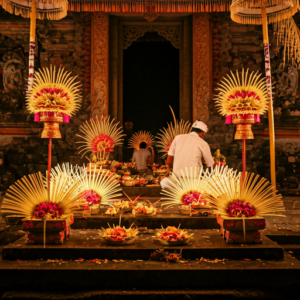Deep in the heart of Indonesia’s most famous island, beyond the pristine beaches and luxury resorts, lies a rich spiritual tradition that has survived centuries of cultural change. Balinese shamanic practices, deeply woven into the fabric of daily life, continue to play a vital role in healing, spiritual guidance, and maintaining harmony between the physical and supernatural worlds.
The Balian: Bali’s Traditional Healers
In Balinese culture, shamanic practitioners are known as „balian“ – a term that encompasses various types of traditional healers and spiritual intermediaries. Unlike the stereotypical image of shamans that many Westerners might hold, balians are ordinary members of their communities who have received their healing gifts through various means: inheritance, apprenticeship, or divine calling.
These practitioners generally fall into several categories:
The Balian Ketakson channels divine knowledge through states of trance, serving as a medium between the physical world and the realm of spirits and deities. When in trance, they may speak with the voices of ancestors or deities, providing guidance and healing to those who seek their help.
The Balian Usada specializes in traditional herbal medicine, drawing upon ancient knowledge preserved in sacred texts called lontar. Their expertise includes the preparation of jamu (herbal medicines) and the understanding of how different plants interact with the body’s energy systems.
The Balian Pica deals primarily with black magic and supernatural afflictions. These specialists are sought out when someone believes they’ve been cursed or affected by negative spiritual forces.
The Spiritual Landscape of Bali
To understand Balinese shamanic practices, one must first grasp the complex spiritual worldview that underlies them. Balinese Hinduism, the predominant religion on the island, differs significantly from Indian Hinduism and incorporates numerous indigenous beliefs and practices.
The Balinese believe in a three-world cosmology: the upper world (swah) of deities, the middle world (bwah) of humans, and the lower world (bhur) of demons and malevolent spirits. Maintaining balance between these realms is crucial for individual and communal well-being.
This belief system recognizes the existence of both sekala (the seen world) and niskala (the unseen world). Balians work at the intersection of these realms, helping people navigate the complex relationships between physical ailments and spiritual causes.
Traditional Healing Practices
Balinese shamanic healing encompasses a wide range of practices, each tailored to the specific nature of the affliction:
Physical Healing
Traditional healing often begins with a diagnostic session where the balian uses various methods to determine the cause of illness. This might involve pulse reading, examining physical symptoms, or spiritual consultation through meditation or trance.
Treatment methods can include:
- Herbal remedies prepared from local plants
- Energy healing through touch or the manipulation of subtle body forces
- Ritual cleansing ceremonies
- Dietary recommendations based on traditional wisdom
- Prayer and meditation practices
Spiritual Healing
Many Balinese believe that physical ailments often have spiritual roots. Spiritual healing might be prescribed when:
- Someone has violated a religious taboo
- Ancestral spirits need appeasement
- Negative energy has accumulated in a person or place
- Black magic is suspected
- A person’s soul needs strengthening
The Role of Ritual
Ritual plays a central role in Balinese shamanic practices. These ceremonies serve multiple purposes: they create a sacred space for healing, invoke divine assistance, and help participants shift their consciousness to a more receptive state.
A typical healing ritual might include:
Preparation
The balian prepares offerings (banten) consisting of flowers, incense, food, and other symbolic items. These offerings serve as bridges between the physical and spiritual worlds, carrying prayers and intentions to the divine realm.
Sacred Space
The healing area is purified and consecrated using holy water (tirtha), incense, and mantras. This creates a protected environment where healing energies can flow freely.
Treatment
The actual healing work might involve:
- Chanting of mantras and prayers
- Use of sacred objects like bells, crystals, or ancient tools
- Application of holy water
- Energy work through touch or movement
- Trance states for spiritual communication
- Ceremonial cleansing
Modern Challenges and Adaptations
Like many traditional practices worldwide, Balinese shamanic healing faces both challenges and opportunities in the modern world. Tourism has brought increased interest in traditional healing, leading to both preservation and commercialization of these practices.
Some balians have adapted their methods to accommodate foreign visitors, while others maintain strictly traditional approaches. This has led to ongoing discussions within the Balinese community about authenticity and cultural preservation.
Integration with Modern Medicine
Many Balinese now take a complementary approach to healing, combining traditional practices with modern medical care. Some hospitals in Bali even incorporate traditional healing methods, recognizing the psychological and spiritual benefits these practices can provide.
The Future of Balinese Shamanic Practices
Despite modernization, Balinese shamanic practices remain vibrant and relevant. Young people continue to learn these traditions, though often in modified forms that reflect contemporary realities.
Several factors contribute to the ongoing vitality of these practices:
Cultural Pride
The Balinese take great pride in their cultural heritage and actively work to preserve traditional knowledge and practices.
Practical Benefits
Many people continue to experience positive results from traditional healing methods, particularly for chronic conditions or issues that western medicine struggles to address effectively.
Tourism Interest
While sometimes leading to commercialization, tourism has also created economic incentives for preserving and documenting traditional practices.
Educational Initiatives
Various organizations work to document and preserve traditional healing knowledge, ensuring it will be available to future generations.
Experiencing Balinese Healing
For those interested in experiencing Balinese shamanic healing, it’s important to approach these practices with respect and cultural sensitivity. This means:
- Understanding that traditional healing is part of a complex cultural and spiritual system
- Respecting the sacred nature of healing practices
- Being willing to engage with the spiritual aspects of treatment
- Following local customs and protocols
- Maintaining realistic expectations about outcomes
Conclusion
Balinese shamanic practices represent a sophisticated system of healing and spiritual wisdom that has evolved over centuries. In today’s rapidly changing world, these traditions offer valuable insights into the relationships between physical, mental, and spiritual well-being.
While facing modern challenges, these practices continue to adapt and evolve while maintaining their essential character. They remind us that healing is not just about treating physical symptoms but about maintaining harmony between the visible and invisible aspects of existence.
For visitors to Bali and those interested in traditional healing practices, these ancient traditions offer not just the possibility of healing but also insights into a worldview that sees humans as part of an interconnected web of physical and spiritual forces. In an age of increasing disconnection and mechanistic approaches to health, such wisdom may be more valuable than ever.






